Volete passare WordPress da HTTP a HTTPS e installare un certificato SSL sul vostro sito web?
Abbiamo ricevuto molte richieste su questo argomento perché Google ha annunciato nel luglio 2018 che il browser Chrome avrebbe contrassegnato tutti i siti web senza SSL come insicuri.
In questo articolo vi mostreremo come spostare correttamente WordPress da HTTP a HTTPS aggiungendo un certificato SSL.
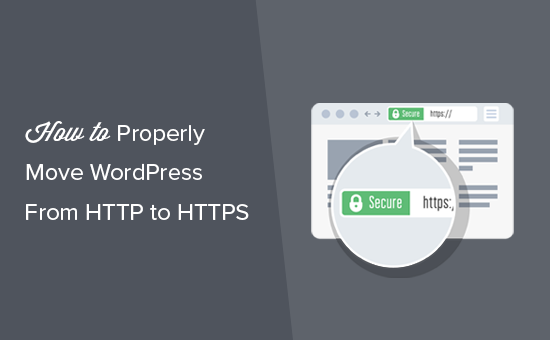
Non preoccupatevi se non avete idea di cosa sia SSL o HTTPS. Vi spiegheremo anche questo.
Che cos’è l’HTTPS?
HTTPS o Secure HTTP è un metodo di crittografia che protegge la connessione tra il browser degli utenti e il vostro server. In questo modo è più difficile per gli hacker intercettare la connessione.
Ogni giorno condividiamo i nostri dati personali con diversi siti web, sia che si tratti di acquisti che di semplici login.
Per proteggere il trasferimento dei dati, è necessario creare una connessione sicura.
A questo punto entrano in gioco SSL e HTTPS.
A ogni sito viene rilasciato un certificato SSL unico a scopo di identificazione. Se un server finge di essere in HTTPS e il suo certificato non corrisponde, la maggior parte dei browser moderni avvisa l’utente di non connettersi al sito.
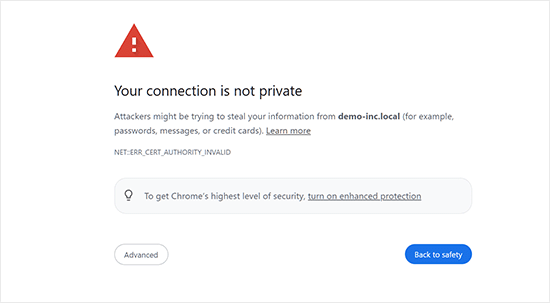
Ora, vi starete chiedendo perché devo spostare il mio sito WordPress da HTTP a HTTPS, soprattutto se si tratta di un semplice blog o di un sito web di una piccola azienda che non raccoglie pagamenti.
Perché avete bisogno di HTTPS e SSL?
Nel 2018, Google ha annunciato un piano per migliorare la sicurezza generale del web incoraggiando i proprietari di siti web a passare da HTTP a HTTPS. Nell’ambito di questo piano, il popolare browser Chrome avrebbe contrassegnato tutti i siti web privi di un certificato SSL come “Non sicuro”.
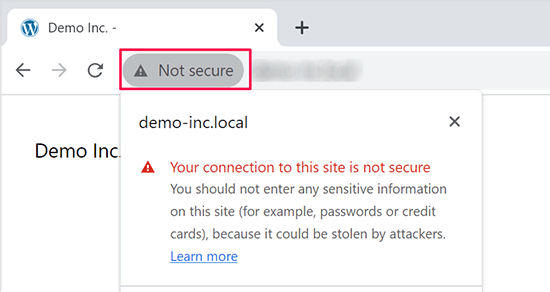
Google ha anche affermato che i siti web con SSL avranno anche benefici SEO e otterranno un posizionamento di ricerca più elevato rispetto ai siti web non sicuri. Da allora, un gran numero di siti web è passato da HTTP a HTTPS.
Dopo l’annuncio, Google ha iniziato a introdurre l’avviso “Non sicuro” in Chrome. Ad esempio, se si visita un sito Web HTTP utilizzando la finestra in incognito, il sito verrà contrassegnato come non sicuro. Se si visita un sito Web HTTP in modalità normale e si cerca di compilare un modulo di contatto o un altro modulo, il sito Web verrà contrassegnato come non sicuro.
Quando i lettori e i clienti vedono questo avviso, danno una cattiva impressione della vostra azienda.
Ecco perché tutti i siti web devono passare da HTTP a HTTPS e installare immediatamente SSL.
Inoltre, se volete accettare pagamenti online sul vostro sito web di e-commerce, avete bisogno di un SSL.
La maggior parte delle società di pagamento, come Stripe, PayPal Pro, Authorize.net, ecc. richiede una connessione sicura prima di accettare i pagamenti.
Utilizziamo il protocollo SSL per i nostri siti web, compresi WPBeginner, OptinMonster, WPForms e MonsterInsights.
Requisiti per l’utilizzo di HTTPS/SSL su un sito WordPress
I requisiti per l’utilizzo di SSL in WordPress non sono molto elevati. Tutto quello che dovete fare è acquistare un certificato SSL, che potreste già avere gratuitamente.
Le migliori società di hosting WordPress offrono certificati SSL gratuiti a tutti i loro utenti:
Per maggiori dettagli, consultate la nostra guida su come ottenere un certificato SSL gratuito per il vostro sito WordPress.
Se la vostra società di hosting non offre un certificato SSL gratuito, dovrete acquistarne uno.
Consigliamo di utilizzare Domain.com perché offre le migliori offerte SSL sia per i certificati SSL normali che per quelli wildcard.
Acquistando un certificato SSL, si ottiene anche un sigillo TrustLogo per il sito web e ogni certificato SSL viene fornito con una garanzia di sicurezza minima di 10.000 dollari. I prezzi partono da 33 dollari all’anno e i certificati SSL vengono rinnovati automaticamente.
Una volta acquistato un certificato SSL, dovrete chiedere al vostro provider di hosting di installarlo per voi.
Impostazione di WordPress per l’utilizzo di SSL e HTTPS
Dopo aver abilitato un certificato SSL per il vostro dominio, dovrete impostare WordPress per utilizzare i protocolli SSL e HTTP sul vostro sito web.
Vi mostreremo due metodi per farlo e potrete scegliere quello più adatto alle vostre esigenze.
Video tutorial
Se preferite le istruzioni scritte, continuate a leggere
Metodo 1: Impostare SSL/HTTPS in WordPress utilizzando un plugin
Questo metodo è più semplice ed è consigliato ai principianti.
Per prima cosa, è necessario installare e attivare il plugin Really Simple SSL. Per maggiori dettagli, consultate la nostra guida passo passo su come installare un plugin di WordPress.
Dopo l’attivazione, è necessario visitare la pagina Impostazioni ” SSL. Il plugin rileverà automaticamente il vostro certificato SSL e imposterà il vostro sito WordPress in modo che utilizzi il protocollo HTTPS.
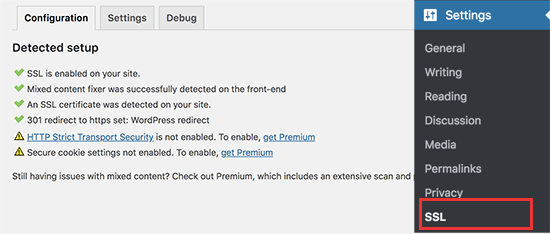
Il plugin si occuperà di tutto, compresi gli errori di contenuto misto. Ecco cosa fa il plugin dietro le quinte:
- Controllare il certificato SSL
- Impostate WordPress per utilizzare https negli URL
- Impostazione di reindirizzamenti da HTTP a HTTPS
- Cercate gli URL nei vostri contenuti che vengono ancora caricati da fonti HTTP non sicure e cercate di risolverli.
Nota: il plugin tenta di risolvere gli errori di contenuto misto utilizzando una tecnica di buffering dell’output. Può avere un impatto negativo sulle prestazioni perché sostituisce il contenuto del sito mentre la pagina viene caricata. Questo impatto è visibile solo durante il caricamento della prima pagina e dovrebbe essere minimo se si utilizza un plugin per la cache.
Anche se il plugin dice che è possibile mantenere SSL e disattivare il plugin in modo sicuro, non è vero al 100%. Dovrete lasciare il plugin sempre attivo perché la disattivazione del plugin riporterà gli errori di contenuto misto. Per maggiori dettagli, consultate la nostra recensione di Really Simple SSL.
Metodo 2: Impostazione manuale di SSL/HTTPS in WordPress
Questo metodo richiede la risoluzione manuale dei problemi e la modifica dei file di WordPress. Tuttavia, è una soluzione permanente e più ottimizzata dal punto di vista delle prestazioni e la stiamo utilizzando su WPBeginner.
Se trovate questo metodo difficile, potete assumere uno sviluppatore WordPress o utilizzare il primo metodo.
Nell’ambito di questo metodo, potrebbe essere necessario modificare i file del tema e del codice di WordPress. Se non l’avete mai fatto prima, consultate la nostra guida su come copiare e incollare frammenti di codice in WordPress.
Per prima cosa, è necessario visitare la pagina Impostazioni ” Generale”. Da qui, è necessario aggiornare i campi dell’indirizzo URL di WordPress e del sito sostituendo http con https.
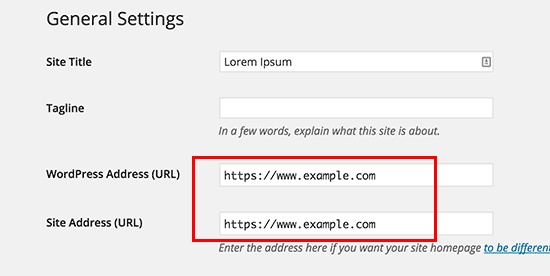
Non dimenticate di fare clic sul pulsante “Salva modifiche” per memorizzare le impostazioni.
Una volta salvate le impostazioni, WordPress vi farà uscire e vi chiederà di effettuare nuovamente il login.
Successivamente, è necessario impostare il reindirizzamento di WordPress da HTTP a HTTPS aggiungendo il seguente codice al file .htaccess:
<IfModule mod_rewrite.c>
RewriteEngine On
RewriteCond %{HTTPS} off
RewriteRule ^(.*)$ https://%{HTTP_HOST}%{REQUEST_URI} [L,R=301]
</IfModule>
Se si utilizzano server NGINX, è necessario aggiungere il seguente codice per reindirizzare da HTTP a HTTPS nel file di configurazione:
server {
listen 80;
server_name example.com www.example.com;
return 301 https://example.com$request_uri;
}
Non dimenticate di sostituire example.com con il vostro nome di dominio.
Seguendo questi passaggi, eviterete l’errore WordPress HTTPS not working perché WordPress ora caricherà l’intero sito web utilizzando HTTPS.
Se si desidera forzare SSL e HTTPS nell’area di amministrazione di WordPress o nelle pagine di login, è necessario configurare SSL nel file wp-config.php.
Aggiungete il seguente codice sopra la riga “That’s all, stop editing!” nel file wp-config.php:
define('FORCE_SSL_ADMIN', true);
Questa riga consente a WordPress di forzare SSL/ HTTP nell’area di amministrazione di WordPress. Funziona anche sulle reti multisito di WordPress.
Una volta eseguita questa operazione, il sito web è completamente configurato per l’utilizzo di SSL/ HTTPS, ma si verificheranno ancora errori di contenuto misto.
Questi errori sono causati da fonti (immagini, script o fogli di stile) che vengono caricate utilizzando il protocollo HTTP non sicuro negli URL. In questo caso, non è possibile vedere l’icona del lucchetto sicuro nella barra degli indirizzi del sito web.
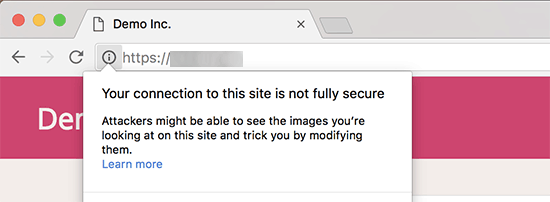
Molti browser moderni bloccano automaticamente gli script e le risorse non sicure.
Potreste vedere un’icona a forma di lucchetto, ma con una notificazione su chi siamo, nella barra degli indirizzi del browser.
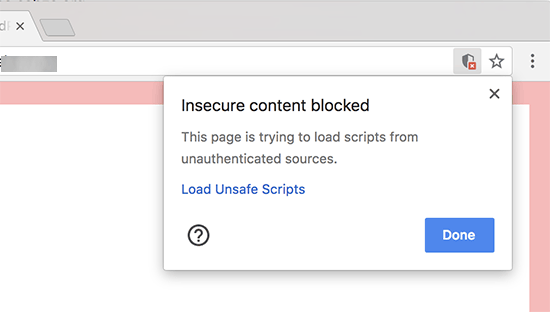
È possibile scoprire quali contenuti sono serviti attraverso un protocollo non sicuro utilizzando lo strumento Inspect.
L’errore di contenuto misto viene visualizzato come un’attenzione nella console con dettagli per ogni elemento di contenuto misto.
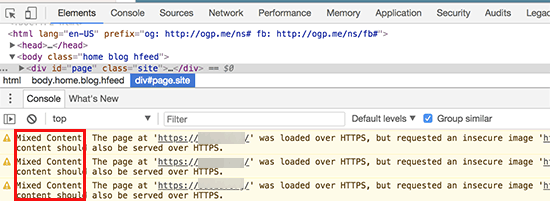
Si noterà che la maggior parte degli URL sono immagini, iframe e gallerie di immagini, mentre alcuni sono script e fogli di stile caricati dai plugin e dai temi di WordPress.
Correggere il contenuto misto nel database di WordPress
La maggior parte degli URL errati saranno immagini, file, embed e altri dati memorizzati nel database di WordPress. Per prima cosa correggiamoli.
È necessario trovare nel database tutte le menzioni del vecchio sito web che iniziano con http e sostituirle con il nuovo sito web che inizia con https.
È possibile farlo facilmente installando e attivando il plugin Search & Replace Everything. Per maggiori dettagli, consultate la nostra guida passo-passo su come installare un plugin di WordPress.
Dopo l’attivazione, è necessario visitare la pagina Strumenti ” WP Search & Replace. Nel campo “Cerca”, dovete aggiungere l’URL del vostro sito web con http. Successivamente, aggiungere l’URL del sito web con https nel campo “Sostituisci”.
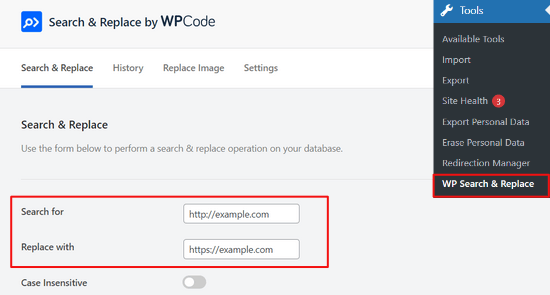
Di seguito, vengono visualizzate tutte le tabelle del database di WordPress. È necessario selezionarle tutte per eseguire un controllo approfondito.
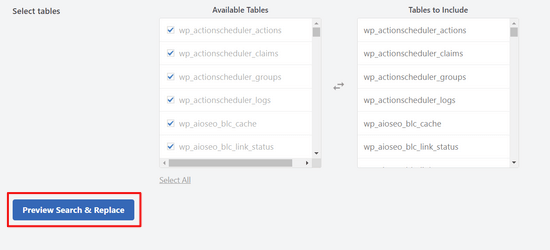
Quindi, fare clic sul pulsante “Anteprima di ricerca e sostituzione” per vedere tutte le modifiche apportate dal plugin. Infine, fare clic sul pulsante “Sostituisci tutto”.
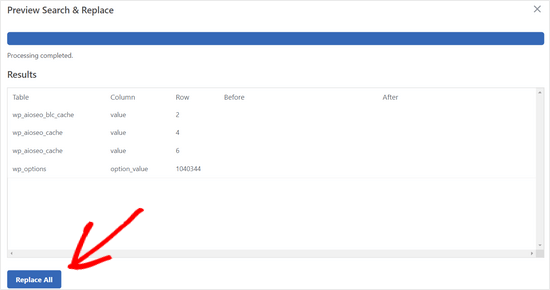
Il plugin cercherà ora nel database di WordPress gli URL che iniziano con http e li sostituirà con URL sicuri https. Potrebbe essere necessario un po’ di tempo, a seconda delle dimensioni del database di WordPress.
Correzione degli errori di contenuto misto nel tema WordPress
Un’altra causa comune degli errori di contenuto misto è il tema di WordPress. Qualsiasi tema WordPress decente che rispetti gli standard di codifica di WordPress non causerà questo problema.
Per prima cosa, è necessario utilizzare lo strumento di ispezione del browser per trovare le risorse e la loro provenienza.
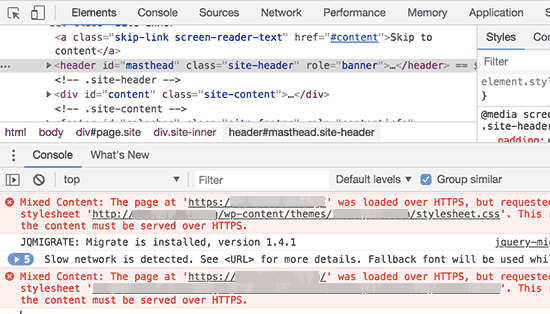
Successivamente, dovrete trovarli nel vostro tema WordPress e sostituirli con https. Questa operazione sarà un po’ difficile per la maggior parte dei principianti, poiché non sarà possibile vedere quali file del tema contengono questi URL.
Correzione degli errori di contenuto misto causati dai plugin
Alcune risorse a contenuto misto vengono caricate dai plugin di WordPress. Qualsiasi plugin di WordPress che rispetti gli standard di codifica di WordPress non causerà errori di contenuto misto.
Non consigliamo di modificare i file dei plugin di WordPress. Dovreste invece contattare l’autore del plugin e farglielo sapere. Se non rispondono o non sono in grado di correggere il problema, è necessario trovare un’alternativa adeguata.
Nota: se per qualche motivo si verifica ancora un errore di contenuto misto, si consiglia di utilizzare temporaneamente il plugin Really Simple SSL, in modo che gli utenti non ne risentano mentre si corregge il problema su un sito web di staging o si assume uno sviluppatore.
Inviate il vostro sito HTTPS a Google Search Console
I motori di ricerca come Google considerano https e http come due siti web diversi. Per evitare problemi di SEO, è necessario comunicare a Google che il sito web è stato spostato.
Per farlo, basta accedere al proprio account di Google Search Console e fare clic sul pulsante “Add-on”.
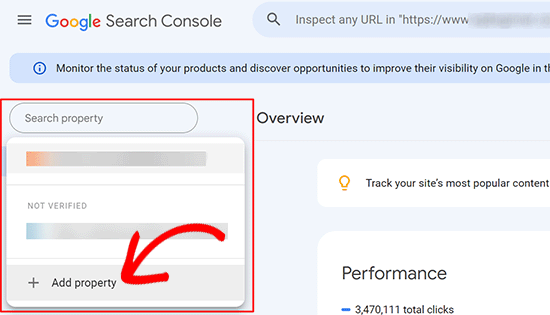
Si aprirà una finestra a comparsa in cui dovrete aggiungere il nuovo indirizzo https del vostro sito web.
Esistono due metodi per la verifica del sito: il nome di dominio o il prefisso URL. Consigliamo il metodo del prefisso URL perché è più flessibile.
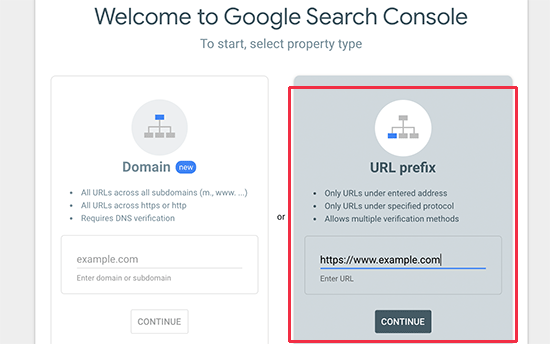
Successivamente, Google vi chiederà di verificare la proprietà del vostro sito web.
Ci sono diversi modi per farlo. Selezionate un metodo qualsiasi e riceverete le istruzioni per verificare il vostro sito. Si consiglia di utilizzare il metodo dei tag HTML.
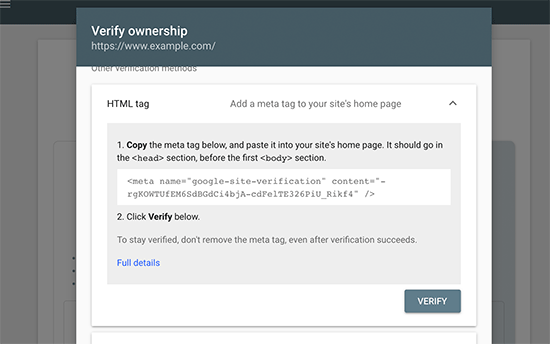
Ora vedrete uno snippet di codice HTML da aggiungere alla sezione head del vostro sito web WordPress.
Aggiungere il codice di verifica di Search Console utilizzando All in One SEO
Innanzitutto, installate e attivate il plugin All in One SEO for WordPress. Per maggiori dettagli, consultate il nostro tutorial su come installare un plugin di WordPress.
Nota: esiste anche una versione gratuita di All in One SEO che potete provare.
Dopo l’attivazione, accedere alla pagina All in One SEO ” Impostazioni generali e fare clic su Google Search Console.
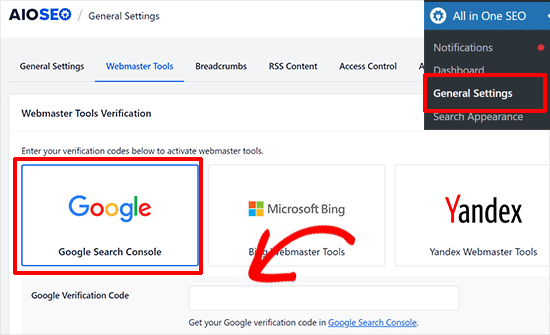
In seguito, è necessario aggiungere il codice di verifica copiato in precedenza dal sito web di Google Search Console.
Non dimenticate di cliccare sul pulsante “Salva modifiche” per memorizzare le impostazioni.
Quindi, tornare alla scheda Google Search Console e fare clic sul pulsante “Verifica”.
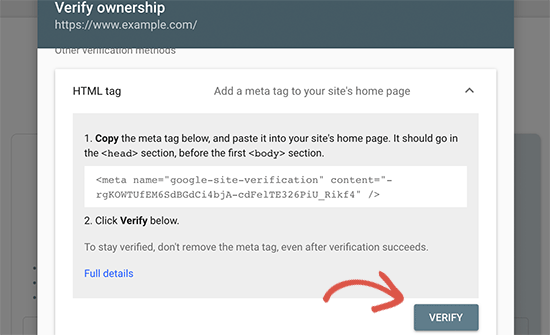
Una volta che il sito è stato verificato, Google mostrerà qui i rapporti della Search Console.
È inoltre necessario assicurarsi che entrambe le versioni https e http siano aggiunte alla Search Console.
Questo indica a Google che volete che la versione https del vostro sito web sia trattata come la versione principale. In combinazione con i reindirizzamenti 301 impostati in precedenza, Google trasferirà le classifiche di ricerca alla versione https del vostro sito web e molto probabilmente noterete dei miglioramenti nelle vostre classifiche di ricerca.
Speriamo che questo articolo vi abbia aiutato ad aggiungere HTTPS e SSL in WordPress. Potreste anche voler consultare la nostra guida definitiva alla sicurezza di WordPress, con istruzioni passo-passo per mantenere sicuro il vostro sito WordPress, oppure la nostra selezione di esperti delle migliori soluzioni di analisi per WordPress.
Se questo articolo vi è piaciuto, iscrivetevi al nostro canale YouTube per le esercitazioni video su WordPress. Potete trovarci anche su Twitter e Facebook.



Syed Balkhi says
Hey WPBeginner readers,
Did you know you can win exciting prizes by commenting on WPBeginner?
Every month, our top blog commenters will win HUGE rewards, including premium WordPress plugin licenses and cash prizes.
You can get more details about the contest from here.
Start sharing your thoughts below to stand a chance to win!
Mrteesurez says
This is really fantastic.
Notinhy is bad as a visitors seeing a website insecured especially an ecommerce that collect online payment from users, this is definitely a bad experience.
That’s why it’s always advisable to have https Website. Choosing one of the hostings you have listed like Bluehost and others gives free SSL and free domain for the first year.
With Bluehost, you don’t need to manually installed the SSL certificate on your website.
Thanks, sharing this.
Moinuddin Waheed says
one of my clients recently purchased a shared hosting from GoDaddy and then asked to make his website.
I started making one and realised that it doesn’t come with inbuilt one click SSL installation like that of hostinger, bluehost and other hosting services providers mentioned above.
The value of having good hosting was evident when I had to go through the painstaking process of getting SSL certificate installed.
it is very advisable that one must choose good hosting service.
Moinuddin Waheed says
Having https for websites is a must for securing the trust of the visitors on the website.
just curious if we have already enabled SSL for our websites, is it necessary to change everywhere from http to https?
or it will automatically take one.
WPBeginner Support says
It would depend on how you enabled SSL and your hosting provider as some will automatically update your site to https while others wont. You would want to check your site to see if it was updated and if not you would need to manually update the site address.
Admin
Jiří Vaněk says
It is usually necessary to manually change everything to https or use the really simple SSL plugin. If part of the site will be http and part will be https, it is called mixed content and will end up with error and problems.
THANKGOD JONATHAN says
If you are beginner and do not know much about coding I recommend you use the first method.
editing your WordPress code is very risky much especially for no coders. After all, the plugin is easier to use and it also have a free version.
Moinuddin Waheed says
Most of the hosting providers now a days give free ssl certificate to your site with a one click install as you have mentioned there.
having ssl certificate installed on website is of utmost importance as it gives a sense of security to the visitors and they can be sure about every thing they do on SSL certificate installed website is secure .
thank you for making a detailed description about http and https.
WPBeginner Support says
You’re welcome
Admin
Nimdaqiu says
I feel like I am no more a beginner now. Thank you for this beautifully detailed article.
WPBeginner Support says
Glad we could help make the process simpler!
Admin
Andrew Meador says
I followed Method 2. The only thing I modified was using the WordPress redirect method. My web host has a tool that creates a redirect (for Windows Server hosting) which adds redirect rules into the web.config – allowing the redirect to HTTPS to happen at the web server level vs at the WordPress level. Works good and is 1 level of abstraction higher. Thanks!
WPBeginner Support says
Thanks for sharing, not all hosting providers offer that but glad your host was able to help
Admin
Clinton Waller says
Thank you very much for this excellent tutorial.
I recently installed an SSL cert and was dreading the change-over with WordPress and Google. Not saying there wasn’t any pain, but your step-by-step instructions helped immensely!
Really appreciated the .htaccess code too, that’s just perfect. I was worried that Google would index both the insecure http and secure https variants of the old vs new website and give me a ranking penalty, but that trick completely avoids serving up insecure legacy http content — a real plus!
William says
I have a mix of domains (all HTTPS) on my WordPress site. Can this plugin go through my site and set them all to my current domain?
WPBeginner Support says
You would want to check with your hosting provider as some have tools for what it sounds like you are wanting to do.
Admin
Long says
There are just no ‘WordPress Address’ and ‘Site Address’ in ‘General Settings’.
Now I use wordpress multisite, one site is https and another is http. This wordpress installation is new, I have already set https at the previous wordpress installation in my sitegroud.
WPBeginner Support says
You would need to go to the network admin to change the URLs of your sites on a multisite installation.
Admin
NIKHIL says
I am Using the First Method So Is There Any Need to Make Changes in WordPress and Site Address URL ??
WPBeginner Support says
So long as there are no hiccups with the plugin you shouldn’t need to edit your address and URL as the plugin would handle that for you.
Admin
Stein says
I followed the steps in method 2, but once I reached the step “Once the settings are saved, WordPress will log you out, and you will be asked to re-login.” instead of just logging me out it also now says that “this site is not avalible” when I try to log in to wp-admin again, making the next steps impossible to do.
So how can I access the wp-admin site following the url change?
WPBeginner Support says
For that specific error, you would want to go through the troubleshooting steps in our article below:
https://www.wpbeginner.com/beginners-guide/beginners-guide-to-troubleshooting-wordpress-errors-step-by-step/
Admin
Jithin says
after adding this home page is redirecting but posts not redirecting to https.
http and https .. both are working .. please help.
WPBeginner Support says
Should you run into that issue, you would want to reach out to your hosting provider to ensure they do not have any redirects set up.
Admin
shantun says
It helps a lot thank you
WPBeginner Support says
Glad our guide was helpful
Admin
RichPat says
Thank you for the SSL upgrade instructions.
Using Really Simple SSL with my hosting provided certificate was a v simple upgrade process
WPBeginner Support says
Glad our guide was helpful
Admin
Michael says
Thanks for your valuable content.please I want to ask,if I can use the Really simple SSL plugin which is easier,why will I want to do it manually.
WPBeginner Support says
That would be mainly for personal preference, there shouldn’t be a major difference between using the plugin or manually changing it.
Admin
Jithin says
Thank you for the guide.
I going to install a fresh WordPress on hostgator. Do I need to do anything different for the HTTPS ? or follow the guide after installation ?
WPBeginner Support says
You can follow our guide after installing your site for enabling https.
Admin
nick Devine says
Hello, I went into settings and changes http to https and now I am locked out of wordpress completely. Do you have a solution to this as it is a clients website and I am concerned I have lost everything completely. Nick
WPBeginner Support says
You would want to enable an SSL certificate for the site or reach out to your hosting provider to assist you in setting the URLs back to HTTP
Admin
Oleksandr Piddubnyy says
First, you need to visit Settings » General page. From here you need to update your WordPress and site URL address fields by replacing http with https.
BUT! After that my page is totally disabled! I can’t backup. I can’t even enter to the admin panel. And I don’t know what’s going on. What should I do? Do you have any idea?
WPBeginner Support says
It sounds like you may have not enabled an SSL certificate on your site before changing the address. You would want to reach out to your hosting provider to enable an SSL certificate for your site or have them change your URLs back to HTTP
Admin
osama khan says
Good day, thank you for the guide. I installed a fresh wordpress on a VPS with an ip addresss. Now, I want to change it to a domain name – Do I need to do anything different for the HTTPS:// ?
WPBeginner Support says
You would want to check with your hosting provider for how their servers are set up for swapping to the domain.
Admin
Araceli says
Hi! So it looks like, after following the steps through “Fixing Mixed Content Errors in WordPress Theme,” I see that my images are causing mixed content issues. The error I am getting is, “This content should also be served over HTTPS.” How can I fix this?
WPBeginner Support says
For fixing the mixed content you would want to take a look at our article below:
https://www.wpbeginner.com/plugins/how-to-fix-the-mixed-content-error-in-wordpress-step-by-step/
Admin
Araceli says
Will do…thank you!
Putri says
would it be okay if I change website address and site address to https but didn’t do the rest of manual process, then install the plugin instead?
WPBeginner Support says
We would recommend if you are planning on using the plugin to start with the plugin method to prevent any hiccups during the process.
Admin
Amar says
Hello Sir,
I have wordpress site running on wordpress 3.5.1 . can I use really simple ssl plugin for it. The plugin says it needs wordpress 4.6 and higher.
Pls suggest me how can i do it
Thanks
WPBeginner Support says
For updating your WordPress site, you would want to follow our guide below:
https://www.wpbeginner.com/beginners-guide/ultimate-guide-to-upgrade-wordpress-for-beginners-infograph/
Admin
Shawn says
I am unable to access the admin login URL after updating the site URLs, it keep redirecting to https but I get a “This site can not be reached error” .. I also tried to update the .htaccess file but no luck. the original website is also not getting redirected to https.
Any ides what might I be missing here?
WPBeginner Support says
You would want to first reach out to your hosting provider for them to take a look and ensure your SSL certificate doesn’t have an issue.
Admin
Lola says
Thank you!
Thank you!
THANK YOU!!!
WPBeginner Support says
You’re welcome
Admin
Kevin says
Thank you, that Plug in Better Search and Replace made the trick!
WPBeginner Support says
You’re welcome, glad our recommendation was helpful
Admin
daniel says
where exactly should I place the code in the .htaccess file?
WPBeginner Support says
The normal location would be beneath the current code in your htaccess file
Admin
Jessica says
Inner pages and post pages are still opening with http also, which will impact on search engines. What should I do now ?
WPBeginner Support says
You would likely need to clear all caching on your site and you may want to check with your hosting provider that the SSL certificate was applied correctly.
Admin
Leos says
Why would you add define(‘FORCE_SSL_ADMIN’, true) to wp-config file if the .htaccess redirect rule already does the job?
When adding the line to wp-config file I got a syntax error right after and it was not possible to get to the admin area.
WPBeginner Support says
The FORCE_SSL_ADMIN is for your admin area to ensure it is using HTTPS. You would want to ensure you copied the entire code correctly. If you were missing the ; it would give a syntax error.
Admin
rohan says
Hello,
Thanks for the detailed guide. After switching from HTTP to HTTPS, I added the new property to Google Search Console.
Do I need to submit the sitemaps again as well on the HTTPS version in GSC?
Beginner query.
WPBeginner Support says
You would want to do that for safety, yes
Admin
Celena says
Thank you! Very helpful!
WPBeginner Support says
You’re welcome
Admin
Phil says
Better Search & replace is 1.3.3 and has not been updated for a year and is not tested on the current wordpress version. It is compatible only up to 5.2.6.
Is it safe to use, or can you recommend an alternative please?
WPBeginner Support says
For those warnings, you would want to take a look at our guide below.
https://www.wpbeginner.com/opinion/should-you-install-plugins-not-tested-with-your-wordpress-version/
Admin
RomRom says
Solution 2 wasn’t working for me, the website would be unavaible.
After a few attemps, I noticed my hosting provider already provides a force https option. Turn it on, and bingo.
WPBeginner Support says
Glad you were able to find a solution that worked for you
Admin
Feranmi says
What of if my hosting provider doesn’t support free SSL certificate can the plugin works also or how can I get it for free?
WPBeginner Support says
If your current host does not offer free SSL then you would want to reach out to them for what options are available.
Admin
Yasir says
Is this plugin is secured.
WPBeginner Support says
Yes, the plugin should currently be secured.
Admin
ammar says
Hi, if i’m using the 1st method, do I need to follow the Submit my HTTPS Site to Google Search Console step also after that?
TQ
WPBeginner Support says
Yes, you would still want to follow that step
Admin
Swen says
I installed the Really Simple SSL plugin, which states that you should manually replace every http:// in all .css and .js files to //. That doesn’t sound really simple to me. As a beginner I set up a simple website with a couple of pictures. Is it common that http:// statements are in these files?
WPBeginner Support says
Normally those links are not common so it shouldn’t be something to worry about.
Admin
Lucas says
Hi,
When adding the code to .htaccess, i get a “too many redirects” error. I tryed adding to the existing code above, below, and also erasing the existing code and using only the new. All three option get too many redirects.
Is there something I should change there? Thanks in advance for your help!
WPBeginner Support says
You would want to try some of the suggestions in our article here:
https://www.wpbeginner.com/wp-tutorials/how-to-fix-error-too-many-redirects-issue-in-wordpress/
for resolving the too many redirects and should those recommendations not work, you would want to check with your hosting provider to ensure they do not have a system that needs to be modified to point to the https version of your site.
Admin
Sotir Sotirov says
I’ve tried using the plugin but when I do the website becomes not accessible. I’ve tried the manual approach but once I’ve changed the addresses in WP settings the site becomes not accessible again.
WPBeginner Support says
You would want to reach out to your hosting provider to ensure that your SSL certificate is connected to your domain correctly and they should be able to help
Admin
Mike Ashworth says
I am about to make the change to SSL and will be following the guidance in te article, initially using the really simple ssl plugin. Before i begin i have a quick question.
If I use the really simple ssl plugin, which takes care of everything, i can leave the general settings in wordpress for wordpress address and site address as http rather than change to https as the plugin will be taking care of it?
WPBeginner Support says
Correct
Admin
Mike Ashworth says
Thanks for confirming. I have one other rquestion.
having just activated lets encrypt ssl on siteground for a website, i am asked wther i want to switch the following on or leave it off.
HTTPS Enforce – Forces your site to work entirely over an encrypted HTTPS connection. The redirect is performed on server level and works for any website.
Do i leave this off as the really simple ssl plugin will take care of this as well?
WPBeginner Support says
Yes, you can leave that off, you would only want to use that should there be any issues with the plugin or Google finding http links
Mike Ashworth says
Thanks for your advice. WP Beginner is such an awesome website. Keep up the great work!
stephan says
I want to thank you a lot. I have been looking for the errors over 12hours and get it done with better replace plugins. Thanks a lot dear.
WPBeginner Support says
Glad our recommendation could help you
Admin
Arlina says
Does adding in the plugin of SSL slow down my blog speed performance?
WPBeginner Support says
It shouldn’t slow your site down
Admin
Peter Wilson says
Can someone tell me, do I replace the contents on my.htaccess. file with the suggested code or do I place it and the beginning/end of the eisting entry.
WPBeginner Support says
You would add it at the end of the current code in your htaccess file.
Admin
Peter Wilson says
Thanks for the quick reply. So, would that be after the existing and before the # END WordPress, or does it go after the .
WPBeginner Support says
That should not matter, it may be a good idea to do it after should you need to remove the code in the future
Shivanandana says
Really awesome guide. Thank you so much! Thanks again for this detailed post!
WPBeginner Support says
Glad you like our content
Admin
Håkan says
Great content, helped me alot!
WPBeginner Support says
Thank you, glad our content was helpful
Admin
Harsha says
Very useful guide, thank you very much!
WPBeginner Support says
You’re welcome, glad our article was helpful
Admin
Jan-Peter Molenaar says
Thanks a lot!! Valuable content
WPBeginner Support says
You’re welcome, glad our content is helpful
Admin
Greg says
This article was so helpful. Thank you so much! Made it very easy.
WPBeginner Support says
You’re welcome, glad our article was helpful
Admin
Nel says
Most helpful guide ever. Thank you for this.
WPBeginner Support says
You’re welcome
Admin
Jessica Quadra says
This was so helpful and each step worked perfectly. Thank you!!
WPBeginner Support says
You’re welcome, glad our guide could help
Admin